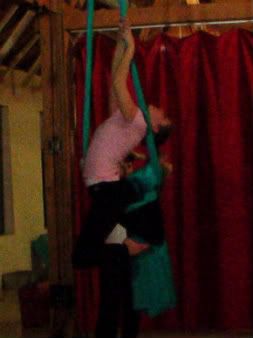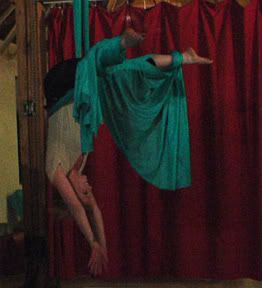The entry in Wikipedia that is the bane of my pedicure.
Old
New Revised version of the entry, including my changes. (Someone made different changes after me, but this still includes my changes).
The first entry didn't have links back to other wiki entries for words such as sylph and ballerina. I don't know about you, but if I weren't a dancer, I would know what a sylph is. So I figured a hyperlink back to the definition of it would be kinda helpful in describing the allure that pointe shoes bring characters who dance on them.
The next edit I made was a little footnote to clarify the word shank. I mean shank is a word that shares many meanings:
It could be a weapon, a poor golf shot, a cut of meat, a bird, part of a ship's anchor... and so on. But none of these give any indication to what part of the shoe it is, (unless you use my shoe as a weapon if you throw it at someone). So I found the Wiki entry for shank, found the ballet definition and added it along with a footnote.
Tuesday, March 25, 2008
Sunday, March 9, 2008
Heels Over Head
Cirque du Soleil training meets Pilates exercise in L.A.’s own Cirque School.
Long, colored tissue and trapeze bars hang from the ceiling, soothing tunes are playing and I realize I've only seen this stuff on television. At Cirque classes you can face your fears, experience an alternative workout and even take a step, er swing toward becoming a bonafide aerial artist.
Not many workouts can beat conquering the fear of being suspended in the air facilitated by your own strength. Instructor and creator of Cirque School L.A. Aloysia Gavre said the feeling of being upside down can become addicting.
"I can't imagine not being upside down everyday,"Gavre said. "It's something about the getting the blood to your head."
Whatever your poison, the class is sure to mix up your monotonous routine and definitely make you sweat.
What else does it take to get through a class you might ask? The proper balance between flexibility and strength.
The beginners classes are suited for beginners or for students who are experienced and need a strengthening regime, while the advanced class caters to more serious artists. But despite the level, body type or physical shape of a student, Gavre said the classes are suitable for anybody and any body type. There is even a specific class on Tuesday nights for men who wish to make functional use of their muscles and stretch out to gain flexibility.
Click here for more information on classes, schedules and instructors for Cirque School.
For more information on the venue and location click here.
The beginner's class consists of an Aerial Fitness series, which take you through warm-up, pilates training, extreme stretching and strengthening techniques. It was amazing to see first-timers conquer their fears and grip the trapeze, with the constant encouragement of the instructors and moral support of the class.
What else does it take to get through a class you might ask? The proper balance between flexibility and strength.
To develop both of these elements, Aerial Fitness classes utilize a routine that thoroughly stretches and strengthens the students in a three minute rotation of stations, called circuit training. There are a few stretch stations, three trapeze levels and aerial fabric.
And I'll tell you, after dancing for over a decade, a simple grounded split couldn't prepare me for a split in mid-air. Once Gavre placed the weight bags on my thighs during my stretch, I felt my inner thighs extend in a way that doesn't happen in a regular dance class.
"You're able to do splits on the ground perhaps, but as soon you get into the air it doesn't look anything like splits because you don't have anything to push off of," Gavre said.
These students stretch in different positions with 20 pound weight bags set in different areas to help stretch muscles in a more effective way. Also, to ensure your comfort for your personal attempt at classes, thick mats line the floors of the room and the instructors use professional spotting techniques to keep your feet safely off the ground.
Gavre developed her teaching technique after performing for 15 years with Cirque du Soleil and decided to bring Cirque School circuit training and a blend of Pilates technique to L.A.
After a student finishes the first aerial fitness training classes for a few months, if they wish to expand their creativity and enrich their performance techniques, they are offered a spot in the Aerialist class. This allows each student to create a performance piece to accentuate their dance or theatrical background. The training focuses more on tricks with the fabric and trapeze, while working with each student's performance abilities and unique goals to create a showcase every six months.
The beginners classes are suited for beginners or for students who are experienced and need a strengthening regime, while the advanced class caters to more serious artists. But despite the level, body type or physical shape of a student, Gavre said the classes are suitable for anybody and any body type. There is even a specific class on Tuesday nights for men who wish to make functional use of their muscles and stretch out to gain flexibility.
After watching both beginners and experienced students conquer their fears, it looks like nothing should stop you from breaking from your normal dance or workout routine and fall head over heels for being... heels over head.
Click here for more information on classes, schedules and instructors for Cirque School.
For more information on the venue and location click here.
Subscribe to:
Comments (Atom)



